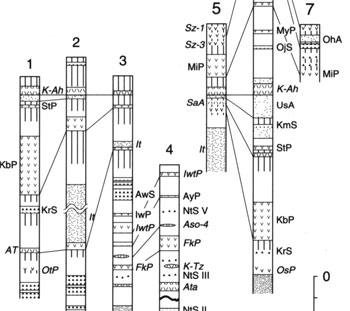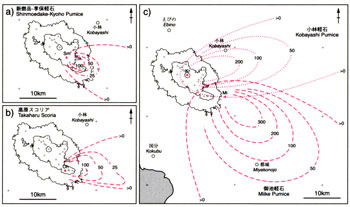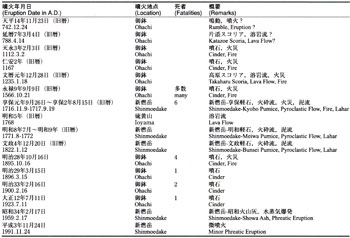Kirishima Volcano
Introduction / Geology of Kirishima Volcano and environs / Topography of Kirishima volcano
History of activities of Kirishima Volcano / Activities of historical times
Monitoring of volcanic activities / Points to be watched for disaster mitigation / Benefit of volcanoes
Acknowledgment / References
![]() PREV
PREV ![]() NEXT
NEXT
History of activities of Kirishima Volcano / Activities of historical times
History of activities of Kirishima Volcano
1 Activities of older Kirishima Volcano
Most ejecta from older Kirishima Volcano are overlain by ejecta of younger Kirishima Volcano and not exposed on the surface. Because of this situation, details of activities of old stage are not well known. However, in drill data for geothermal development, rocks belonging to older Kirishima Volcano are always met at depths below younger deposits. From this it is safe to conclude that the framework of the Kirishima Volcano Group has been prepared by deposits of older Kirishima Volcano.
2 Activities of younger Kirishima Volcano
By the activities belonging to this stage, Kirishima Volcano as we see them today has been made. The history of activities is reasonably well known from sequence of tephra deposits in the east( ![]() Fig. 3 ).
Fig. 3 ).
Activities from 300,000 yBP to hundred something yBP
Activities belonging to this period are lava flows of unknown source(s) distributed in NW foot areas of Kirishima Volcano, such as Eboshidake, Kurinodake, Yunotanidake, Shishigodake, Yadake, and an unnamed peak ( 1046.9 m a.s.l. ) to the SW of Kurinodake. Some of them show advanced stage of erosion and lost traces of craters. Lava flows of this stage have radiometric ages from 0.2±0.04 to 0.1±0.04 Ma (Ma means million years before the present).
Sequence of tephra deposits in the east of Kirishima Volcano as well as radiometric ages of rocks and eroded topography of the volcanic bodies indicate that the activities had some hiatus around 100,000 years ago.
Activities from 100,000 yBP to 25,000 yBP
Activities of this period are scattered through most of the areas of Kirishima Volcano, and formed volcanic bodies such as Shiratoriyama, Ebinodake, Ryuodake, Futagoishi, Onamiike, Hinamoridake, and Ohatayama. Lava flows belonging to this period still keep large topographic features such as terminal cliffs, but micro-topography such as surface wrinkles have been obscured and not observable.
From tephra deposits in the east of Kirishima Volcano, it is inferred that the volcanoes had repeated explosive eruptions during 65,000 to 35,000 yBP. A pumice bed named Iwaokoshi pumice erupted from Onamiike about 60,000 yBP is comparatively widespread and can be traced to Miyazaki Plain 50 km away. The Onamiike pyroclastic cone is believed to have formed by this eruption. It seems that this was preceded by formation of a small stratovolcano largely made of lavas.
Several scoria layers deposited between 50,000 and 30,000 yBP are recognized above Iwaokoshi pumice bed. Those scoria beds are identified to have ejected from Hinamoridake area. Rock avalanche deposits distributed in the north foot of Hinamoridake are interbedded with these scoria beds.
Because no humus deposit exists between rock avalanche deposits and overlying scoria bed, collapse of the mountain which resulted in avalanche deposits seems to have been followed immediately by activity of Hinamoridake. The timing of the collapse of Hinamoridake is estimated to be about 38,000 yBP and the volcanic activities continued until about 35,000 yBP.
In the region of Kirishima Volcano, Ito Pyroclastic Deposits originated from Aira caldera is often underlain immediately by thick bed of humus indicating that between the last activity of Hinamoridake and deposition of Ito Pyroclastic Flow ( from 35,000 to 25,000 yBP ), the Kirishima Volcano was comparatively quiet.
Activities between 25,000 and 6,300 yBP
Volcanic activities of this period produced small-sized stratovolcanoes including Maruokayama, Iimoriyama, Koshikidake, Karakunidake, Shinmoedake, Nakadake, and Takachiho-no-Mine, as well as younger lava flows of Shiratoriyama and Rokkannon-Miike, NW of Karakunidake. Those eruption centers tend to align in NW-SE direction which determines overall elongated distribution of the Kirishima Volcano.
About 18,000 yBP, there was an eruption near where Karakunidake now stands, and Karakunidake scoria seems to have formed small stratovolcano. At about the same time, Koshikidake and Shinmoedake seem to have formed. About 15,000 yBP, Karakunidake erupted Kobayashi pumice bed ( see ![]() Fig. 4 c ) which concluded formation of Karakunidake as we see today.
Fig. 4 c ) which concluded formation of Karakunidake as we see today.
After Karakunidake eruption, comparative quiescent period from 15,000 to 7,000 yBP prevailed except for Setao pumice eruption from Shinmoedake at about 9,000 yBP. About 7,000 yBP, Takachiho-no-Mine located at SE part of Kirishima Volcano became active. Ushi-no-Sune ash is erupted during its growth, representing a product of long and intermittent activities. Kikai-Akahoya ash erupted from Kikai caldera 6,300 years ago occurs interbedded with Ushi-no-Sune ash and separates the latter to upper and lower members.
Activities of last 6,300 years
Activities of last 6,300 years of younger Kirishima Volcano are concentrated within SE region of the volcanoes. After the formation of Takachiho-no-Mine, Miike and Ohachi craters were created. Miike is a maar formed by Plinian eruption about 4,200 yBP. This was the largest eruption among known explosive activities in Kirishima Volcano. A deposit from a base surge is intercalated in Miike pumice around Miike (see ![]() Fig. 4
c). At about the same time of explosive eruption at Shinmoedake, lava extrusions occurred at Fudoike, Ioyama, Ohatayama (younger stage), and at summit of Nakadake.
Fig. 4
c). At about the same time of explosive eruption at Shinmoedake, lava extrusions occurred at Fudoike, Ioyama, Ohatayama (younger stage), and at summit of Nakadake.
Activities of historical times
Over ten highly reliable eruption records are known to exist for Kirishima Volcano after A.D.742 ( 14th year of Tenpyo ) ( ![]() Table 2 ). The records contain information on numbers of casualties, burnt temples, shrines, and houses, damage to agricultural produces, and livestock. Recorded eruptions are mostly related to Ohachi and Shinmoedake, but in 1768 ( 5th year of Meiwa ) Ioyama at the NW foot of Karakunidake was formed.
Table 2 ). The records contain information on numbers of casualties, burnt temples, shrines, and houses, damage to agricultural produces, and livestock. Recorded eruptions are mostly related to Ohachi and Shinmoedake, but in 1768 ( 5th year of Meiwa ) Ioyama at the NW foot of Karakunidake was formed.
Eruptions in A.D. 788 ( 7th year of Enreki ) and 1235 ( 1st year of Bunreki ) at Ohachi, and that of 1716-17 ( 1st and 2nd years of Kyoho ) of Shinmoedake were large enough to cause complete changes of outline of both volcanoes.
Ejecta corresponding to eruptions of A.D. 788 and 1235 in Ohachi are distributed in the eastern foot of Kirishima Volcano as Katazoe scoria and Takahara scoria ( see ![]() Fig. 4 b ). At least three units are recognized in Takahara scoria suggesting intermittent large explosions. The 1235 eruption was the largest in historical times in Kirishima Volcano. Repeated eruptions continued at Ohachi since that time, especially during last half of 1800s to 1923. Frequent eruptions like present day Sakurajima eruptions have occurred, and casualties to sightseers are considerable. In recent years at Ohachi, only small fumarolic activity within the crater is observed and it seems to be quiet, but in 2000 notable earthquakes were recorded immediately below the crater.
Fig. 4 b ). At least three units are recognized in Takahara scoria suggesting intermittent large explosions. The 1235 eruption was the largest in historical times in Kirishima Volcano. Repeated eruptions continued at Ohachi since that time, especially during last half of 1800s to 1923. Frequent eruptions like present day Sakurajima eruptions have occurred, and casualties to sightseers are considerable. In recent years at Ohachi, only small fumarolic activity within the crater is observed and it seems to be quiet, but in 2000 notable earthquakes were recorded immediately below the crater.
Eruptive activity of Shinmoedake in 1716-17 started with phreatic explosion followed by phreatomagmatic, then magmatic, with passing of the time. During this activity, pumiceous eruptions ( see ![]() Fig. 4 a ) were accompanied by base surges, pyroclastic flows, and mud flows repeatedly according to the analysis of related deposits. Also according to records, wide areas in the east suffered damage on agricultural produces and even by fire from coarse-grained tephra fall. Ash fall was observed in Hachijojima Island about 850 km away, and the eruptions continued intermittently for a year and half. At Shinmoedake, a phreatic explosion occurred in 1959 and in 1991 a small eruption after notable earthquake activities.
Fig. 4 a ) were accompanied by base surges, pyroclastic flows, and mud flows repeatedly according to the analysis of related deposits. Also according to records, wide areas in the east suffered damage on agricultural produces and even by fire from coarse-grained tephra fall. Ash fall was observed in Hachijojima Island about 850 km away, and the eruptions continued intermittently for a year and half. At Shinmoedake, a phreatic explosion occurred in 1959 and in 1991 a small eruption after notable earthquake activities.


